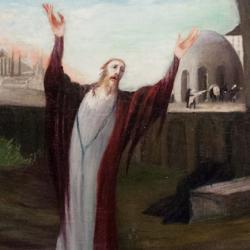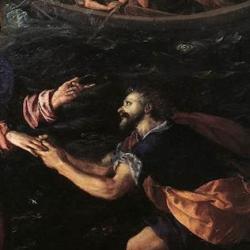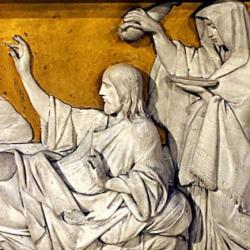INTRODUCTION
Jesus’ long day of battle in the temple began with three parables (Matthew 21:23-22:14 ) that condemned Israel ’s leaders. One by one, these leaders – Herodians, Sadducees, Pharisees ( 23:15 -40) – approach Jesus to trap Him, and one by one they are put beneath the feet of the son of David ( 23:44 ).
THE TEXT
“The same day the Sadducees, who say there is no resurrection, came to Him and asked Him, saying: ‘Teacher, Moses said that if a man dies, having no children, his brother shall marry his wife and raise up offspring for his brother . . . .’” (Matthew 22:23-46).
GOD OF THE LIVING
Each of these groups confronts Jesus with one of the divisive issues in first-century Judaism: Relations with Rome ( 22:15 -22), the resurrection ( 22:23 -32), and the law ( 22:34 -40). Sadducees were the party of the priesthood (cf. Acts 4:1; 5:17 ), the aristocracy of Israel . Being the privileged class, they resisted the socially disruptive notion that dead people could live again. They present to Jesus a scenario designed to expose the absurdity of belief in the resurrection. They also try to show that belief in resurrection creates contradictions in the Torah, which prescribes the levirate marriage (Deuteronomy 25:5-10) and prohibits polyandry. In response, Jesus first says that marriage will no longer exist in the resurrection ( 23:30 ), since individual marriages will be fulfilled in the marriage of the Lamb. Further, he points the Sadducees to the basic confession of Israel : Yahweh bound Himself to Abraham, Isaac, and Jacob, and He won’t let a little obstacle like death break that bond.
GREATEST COMMANDMENT
Seeing the Sadducees reduced to shamed silence, the Pharisees bring one last test (v. 35). They expect Jesus to renounce the law entirely, or bring offense by emphasizing or neglecting some cherished part of Torah. Instead, Jesus quotes the Torah itself (v. 37 with Deuteronomy 6:5; v. 39 with Leviticus 19:18 ). The first commandment, to love God with everything we are, is part of the Jewish Shema . It is intimately connected to the second commandment, since love of God expresses itself in loving action toward neighbors. Jesus says this dual love is the whole point of the law and prophets, the result that the law and prophets aimed to achieve.
SON OF DAVID
The interrogation ends, and Jesus turns the tables and poses a riddle to the Pharisees. He returns to the question that alarmed the Jewish leaders in the first place, His identity as “son of David” (cf. 21:9, 15). This has been the underlying question throughout the day of parables and traps: Who is Jesus? Jesus doesn’t answer the question directly, but instead poses a question that the Pharisees cannot answer. Psalm 110:1 says, “Yahweh said to my Lord.” Jesus’ argument is: David wrote the Psalm; the Psalm is about the Messiah, who is David’s son; yet David, against all natural logic, calls his own son his “lord.” We know that Jesus is the son of David who will be exalted to the Father’s right hand, and that He is also the eternal Son of God. But the Pharisees don’t have the categories to answer the question. They give no answer, bringing the day of testing to an embarrassed end. In Matthew’s gospel, the Pharisees never speak to Jesus again (cf. 27:62).











